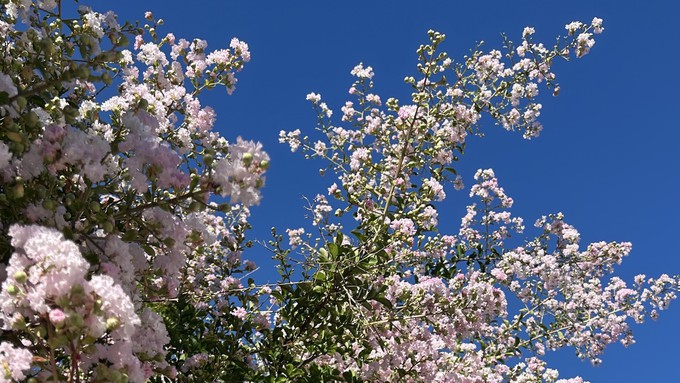
The ubiquitous tree gives summer landscapes some pop

The fluffy blossoms of the crape myrtles (Lagerstroemia indica) give Sacramento summers plenty of landscape color. Some people aren’t fond of the blossom “snow,” however. Kathy Morrison
How drab the height-of-summer landscape would be without crape myrtle trees.
One of my three crape myrtles is blooming its head off. The light pink blossoms weigh down the branches so much that I emerge with a crown of flowers when I walk underneath. The purple-flowering tree in front and the violet-pink one in back will be showing their colors soon.
Two of these trees were here when we bought our house; I added the third crape myrtle to shade a window.
(Wait, isn't that spelled CREPE myrtle?)
Well, yes, both spellings are correct, but I see that the online Florida company that sells these trees exclusively calls itself The Crape Myrtle Company. So we'll go with that.
I had to laugh when I looked through their catalog: There's a miniature variety, blooming bright deep red, called the Sacramento. It grows to just 2 feet tall. That size would be easy to tuck under the standard variety, rather than the more commonly planted agapanthus.
I do enjoy these trees. They're not too tall, they provide great shade and color in summer, and their roots behave. In winter they pretty much disappear -- except for that pretty bark -- so what daylight we get is not blocked.
My childhood house had a hedge of classic hot-pink crape myrtles, grown as bushes. We played with the buds, squeezing them until they popped open.
But not everyone is a fan. Maybe the trees were not planted in the right location, spilling their blossoms all over the sidewalk or cars. Some varieties are susceptible to powdery mildew. Sometimes they attract aphids, which can mean sticky honeydew and sooty mold ruining the look of the plant.
But the worst problem with these trees is caused by humans: "crape murder." That's the severe pruning of the trees, supposedly to control the size and/or increase blooming. I particularly hate the pruning that, after a few years, leaves knobby "knuckles"on the tree, from which a "witch's broom" of weak branches sprouts.
I found an excellent description of this crime -- and how to remedy it -- on the Southern Living website here:
Now, I know crape myrtles are not natives. Blooming native trees of the same size include the desert willow; we may see more of those in landscapes as native plants gain wider acceptance.
But our hot summers would be less colorful without crape myrtles, and it always cheers me to see them in bloom. I don't even mind brushing all those pink blossoms out of my hair.
Comments
0 comments have been posted.Sacramento Digs Gardening to your inbox.
Food in My Back Yard Series
April 22: Should you stock up on fertilizer? (Yes!)
April 15: Grow culinary herbs in containers
April 8: When to plant summer vegetables
April 1: Don't be fooled by these garden myths
March 25: Fertilizer tips: How to 'feed' your vegetables for healthy growth
March 18: Time to give vegetable seedlings some more space
March 11: Ways to win the fight against weeds
March 4: Potatoes from the garden
Feb. 25: Plant a fruit tree now -- for later
Feb. 18: How to squeeze more food into less space
Feb. 11: When to plant? Consider staggering your transplants
Feb. 4: Starting in seed starting
Sites We Like
Garden Checklist for week of April 27
Once the clouds clear, get to work. Spring growth is in high gear.
* Set out tomato, pepper and eggplant transplants.
* From seed, plant beans, beets, cantaloupes, carrots, corn, cucumbers, melons, pumpkins, radishes and squash. Plant onion sets.
* In the flower garden, plant seeds for asters, cosmos, celosia, marigolds, salvia, sunflowers and zinnias. Transplant petunias, zinnias, geraniums and other summer bloomers.
* Plant perennials and dahlia tubers for summer bloom. Late April is about the last chance to plant summer bulbs, such as gladiolus and tuberous begonias.
* Transplant lettuce and cabbage seedlings.
* Weed, weed, weed! Don’t let unwanted plants go to seed.
* April is the last chance to plant citrus trees such as dwarf orange, lemon and kumquat. These trees also look good in landscaping and provide fresh fruit in winter.
* Feed citrus trees with a low dose of balanced fertilizer (such as 10-10-10) during bloom to help set fruit. Keep an eye out for ants.
* Apply slow-release fertilizer to the lawn.
* Thoroughly clean debris from the bottom of outdoor ponds or fountains.
* Start thinning fruit that's formed on apple and stone fruit trees -- you'll get larger fruit at harvest (and avoid limb breakage) if some is thinned now. The UC recommendation is to thin fruit when it is about 3/4 of an inch in diameter. Peaches and nectarines should be thinned to about 6 inches apart; smaller fruit such as plums and pluots can be about 4 inches apart. Apricots can be left at 3 inches apart. Apples and pears should be thinned to one fruit per cluster of flowers, 6 to 8 inches apart.
* Azaleas and camellias looking a little yellow? If leaves are turning yellow between the veins, give them a boost with chelated iron.
* Trim dead flowers but not leaves from spring-flowering bulbs such as daffodils and tulips. Those leaves gather energy to create next year's flowers. Also, give the bulbs a fertilizer boost after bloom.
* Pinch chrysanthemums back to 12 inches for fall flowers. Cut old stems to the ground.
* Mulch around plants to conserve moisture and control weeds.